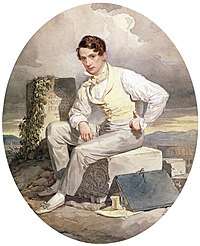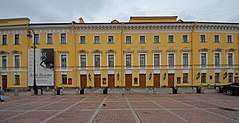Alexander Brullov
Alexander Pavlovich Brullov (Russian: Александр Павлович Брюллов, spelled Brulleau until 1822, when the family name was changed according to Russian pronunciation, sometimes also spelled Brulloff; 29 November 1798 – 9 January 1877) was a Russian artist associated with Russian Neoclassicism.
Alexander Brullov | |
|---|---|
Александр Павлович Брюллов | |
 Alexander Brullov (self-portrait) (1830) | |
| Born | November 29, 1798 Saint Peterburg |
| Died | January 9, 1877 (aged 78) Saint Peterburg |
| Education | Member Academy of Arts (1831) |
| Alma mater | Imperial Academy of Arts (1821) |
| Known for | Painting, Architecture |
Early life
Alexander Brullov was born in Saint Petersburg into a family of French artists: his great grandfather, his grandfather, his father and his brothers (including Karl Brullov) were artists. His first teacher was his father Paul. He attended the Imperial Academy of Arts architecture class from 1810 to 1820, and graduated with honors. Along with his brother, Karl, he was sent to Europe to study art and architecture with a stipend from the Society for the Promotion of Artists.
Career
Alexander Brullov spent eight years abroad, from 1822 to 1830, in Italy, Germany and France, studying architecture and art. He painted many watercolor portraits at that time. Among the best were those of Yekaterina Pavlovna Bakunina, John Capodistria, Natalya Goncharova-Pushkina, wife of the Russian poet Alexander Pushkin and Yekaterina Ivanovna Zagryazhskaya, her aunt. He also did illustrations for books and magazines.
In 1831, after his return to Russia, he was appointed professor at the Imperial Academy of Arts and these were the years when he created his best architectural projects. Among others, he designed and supervised the construction of the following buildings in Saint Petersburg:
- Mikhailovsky Theatre (now Maliy Theater, 1831–1833)
- Lutheran Church of Saint Peter and Saint Paul on Nevsky Prospekt (1833–1838)
- Pulkovo Observatory (1834–1839)
- The Guard Corps Headquarters on Palace Square (1837–1843).
He was one of the principal architects for the reconstruction of the Winter Palace after the fire of 1837. He designed many striking interiors there, including the Pompei Hall, the Malachite Room, and the White Hall.
In 1844 he designed and built Orenburg Caravanserai in Orenburg.
His son Pavel also became a painter of some note.
Buildings designed by Brullov



 East side of Palace Square
East side of Palace Square
Writings
- Thermes de Pompéi. A. Firman Didot, Paris, 1829.[1]
References
- Thermes de Pompéi arachne.uni-koeln.de Retrieved 22 November 2017.
Literature
- С. Н. Кондаков (1915). Юбилейный справочник Императорской Академии художеств. 1764-1914 (in Russian). 2. pp. 298–299.
External links
![]()